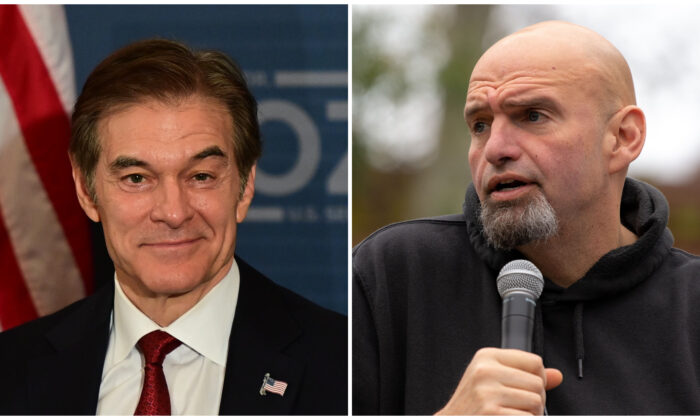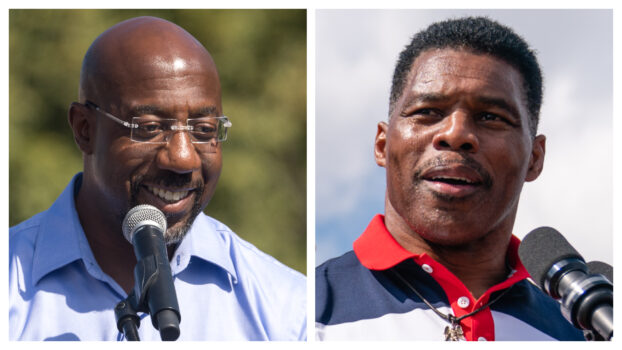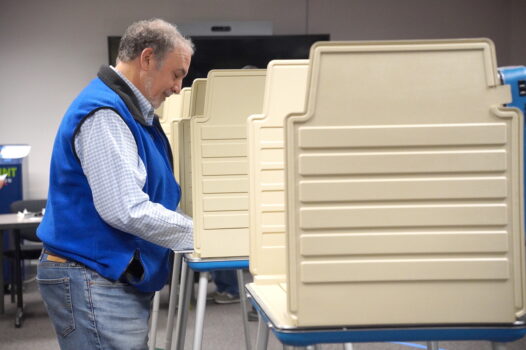
(Left) Republican Senate candidate Dr. Mehmet Oz hosts a safer streets community discussion at Galdos Catering and Entertainment in Philadelphia on Oct. 13, 2022. (Mark Makela/Getty Images); (Right) Pennsylvania’s Lieutenant Governor John Fetterman speaks to supporters gathered in Dickinson Square Park in Philadelphia on Oct. 23, 2022. (Kriston Jae Bethel/AFP via Getty Images)
News Analysis
Polls of prospective voters, which have been widely cited throughout the 2022 midterm races, are based on flawed methodology, and their use as a tool to achieve the outcome desired by the mainstream media has been conspicuous during this election cycle, political strategists and polling experts have told The Epoch Times.
Whatever limited use polls may have, one of their likely consequences, in the current politicized environment, is the “bandwagon effect.” This describes a phenomenon where the media misuse polls to demoralize political opponents and their supporters and to suggest to undecided voters that they are out of step with majoritarian and mainstream sentiment if they do not get on board with the candidate or candidates whom the polls favor, one expert said. Hence polls favoring candidates whom the media want to win become self-fulfilling prophecies.
Poll results from such sources such as FiveThirtyEight and RealClearPolitics, along with those in mainstream media outlets such as the New York Times, have consistently favored Democrat candidates in the closely watched Senate and gubernatorial races, though the margins have shrunken since the summer.
For example, FiveThirtyEight’s latest polling averages for the Pennsylvania Senate race show Democrat John Fetterman, the state’s lieutenant governor, ahead of Donald Trump-endorsed Republican Dr. Mehmet Oz by a slight margin, 46.9 percent to 46 percent, even after an Oct. 25 debate in which Fetterman gave a halting and confused performance that came in for harsh criticism from commentators on both sides of the aisle. On Aug. 10, the same source showed Fetterman with a roughly 12-point lead over Oz, 49.2 percent to 37.3 percent.
In Georgia’s closely-watched Senate race between Democrat incumbent Raphael Warnock and Trump-endorsed Republican challenger Hershel Walker, FiveThirtyEight’s latest data show a race nearly as tight, with Warnock enjoying 46.7 percent support and Walker 45.4 percent. On July 31, Warnock had a reported three-point lead, 47.2 percent to 44.2 percent.

FiveThirtyEight’s projections are largely aligned with those put forward in mainstream and legacy media organs. On Oct. 31, the New York Times published the findings of a poll that the newspaper undertook in partnership with Siena College.
According to the poll, Fetterman still commands a marked lead over Oz, 49 percent to 44 percent, the Oct. 25 debate notwithstanding, and Warnock is well ahead of Walker, 49 percent to 46 percent. In Arizona’s intensely followed Senate race, the same poll gives Democrat Mark Kelly a considerable lead over Republican challenger Blake Masters, 51 percent to 45 percent.
The Dobbs Bump
Pundits and pollsters who favor Democrats in these races are engaging, to one or another degree, in wishful thinking, believes Lonny Leitner, vice president of the government affairs firm LS2 Group, which has offices in Iowa and Minnesota.
The bounce in opinion polls that Democrat candidates enjoyed well into the summer and early fall was largely a function of some voters’ wariness over the Supreme Court’s June 24 ruling in Dobbs v. Jackson Women’s Health Organization, which overturned Roe v. Wade, Leitner believes. It is a mistake to construe that short-term reaction as a broad endorsement of Democrat candidates and their views on issues as varied as crime, inflation, border security, the Ukraine crisis, and other issues.
“I think we are seeing that the Democrats peaked too soon as they got a big bounce this summer shortly after the Supreme Court decision re. Roe v. Wade. Polls show that abortion isn’t even the top-three issue for the majority of Americans when asked. Everything is coming back to inflation, the economy, gas prices, and crime,” Leitner said.
But a larger mistake made by pollsters is a methodological one, Leitner argued. Often, polls sample a relatively tiny portion of the electorate. The New York Times-Siena College poll cited above is an example. Its results for the Georgia and Arizona races were based on answers given by a reported 604 potential voters in each state, out of total voting-age populations of 8,275,264 and 5,662,328, respectively, and in Pennsylvania, only a reported 620 voters gave their input to the pollsters, out of a voting-age population of 10,018.510.
These statistically minuscule slivers of the states’ voting-age populations thus cannot be expected to provide reliable samples on which to generalize about the likely outcome of critical races, and the numbers of respondents here are actually at the high end, with many polls sampling four to five hundred prospective voters or even fewer.

Preaching to the Choir
Another problem, Leitner said, is that polls often sample voters registered with one or another party, which limits still further their pools of respondents and renders their results practically meaningless.
“People who are looking at polls where the sample is [made up of] registered voters are wasting their time, because those polls are designed to make Democrats look good. People need to focus on polls that have a larger sample, like 1,000 voters, and they need to be ‘likely voters’ versus registered voters,” Leitner said.
Moreover, polls often fail to take into account the momentum generated by successful candidates in races outside the scope of the polls, which can carry over into the races that the polls do address, the analyst posited. This is particularly the case for independents and voters who have not yet made up their minds.
“When looking at those polls, you will see that Republican candidates from Oregon to Arizona to North Carolina are getting some wind at their backs largely because the GOP base is coming home and undecided voters who aren’t necessarily Republicans know they don’t want Joe Biden and the Democrats,” he said.
Leitner sees this spillover effect as potentially playing a decisive role in Georgia, where even polls normally unfavorable to GOP candidates give Governor Brian Kemp a five-point-plus lead over opponent Stacey Abrams. Kemp’s success may help Walker win the Senate contest and tip the balance in that body in favor of the GOP, Leitner suggested.
In Leitner’s view, this dynamic could play out in reverse in Wisconsin, where the success of GOP senatorial candidate Ron Johnson, who currently enjoys a three-point lead over Democrat Mandela Barnes, may end up helping Republican insurgent Tim Michaels defeat incumbent Democrat Governor Tony Evers.
Chronic Polling Woes
The flawed methodology and partisan misuse of polls have led many voters and political observers to doubt their legitimacy or discount them entirely, and the problems that led to wildly inaccurate predictions in the past—such as the New York Times issuing a forecast days before the 2016 election that Hillary Clinton had a 91 percent chance to become president, and Donald Trump only a nine-percent chance—persist to this day, some believe.
“The pollsters claim they fixed their polling for 2022, but I doubt it. There appears to be a bias towards the Democrats by the major media polls, but we won’t really know until the votes are counted. The thing about polling is that it is an estimation, which is always a bit uncertain. But the major media polls’ errors always seem to favor the Democrats,” Keith Naughton, the principal of Silent Majority Strategies, a political consultancy based in Germantown, Maryland, told The Epoch Times.
“I think the Democrats could be in for a rude awakening by pinning their hopes on unreliable polls that tell them what they want to hear. Bad polling does not help anyone, it just damages the credibility of the media even more,” he added.
Mixed Blessings
Even experts who see the utility of polling in the context of political races acknowledge that there are things that the media could do to improve their methodology, and avoid shunting aside or denying the existence of constituencies that do not fit into their vision.
“I’m a proponent of polling. I think it’s incumbent on those who study democracy to make a solid effort to ascertain what people think,” Daron Shaw, a professor at the University of Texas at Austin, told The Epoch Times.
“There are people who do it earnestly and do it well. There may be some hacks, but more often than not, you’re talking about people who are credentialed and making a good-faith effort to find out what’s going on,” he added.
Yet even the most sophisticated methodologies come up against the fact that some constituencies are simply more responsive than others, and it just so happens that some of the prospective voters least likely tell pollsters anything tend to lean Republican, Shaw acknowledged.
“Scientifically, it’s absolutely solid, but there are enormous challenges to polling effectively in modern contexts,” he said.
As an example of the difficulties pollsters come up against, Shaw pointed to the constituency that Trump set out to galvanize in 2016 and 2020.
“Trump and others told us they were going to go out and identify those voters, less well-educated whites, who feel that they’ve been left behind. ‘We’re going to find those voters and register them.’ And people who followed voting in the Upper Midwest said, ‘Good luck,’” Shaw said.
But the Trump campaign was aggressive in pitching to these voters, and was successful. “The numbers are fairly indisputable,” he noted.
These efforts led to a high turnout for Trump in 2016 among blue-collar whites, many of whom, Shaw observed, were part of a constituency that had voted Democrat going back to the administration of Franklin Delano Roosevelt.
In the 2016 race, Trump narrowly won both Michigan, Wisconsin, and Pennsylvania by margins of 0.23 percent, 0.77 percent, and 0.72 percent, respectively.
“They turned pretty Republican, and I mention that only because that’s where all the energy has been concentrated. There were lower response rates for this particular constituency, and they were slightly underrepresented [in polling] in 2016 and maybe again in 2020,” Shaw said.
The mistakes made in the past occurred through a large swath of blue-collar America, including a state, Pennsylvania, where a Senate race that has gained international attention and is considered crucial to the balance of power in Washington now unfolds.
“In 2016, the big misses were in the Upper Midwest states—Wisconsin, Michigan, and Pennsylvania—and those places were significantly under-polled,” Shaw acknowledged.
Nate Silver, the director of FiveThirtyEight, did not respond by press time to a request for comment from The Epoch Times.
